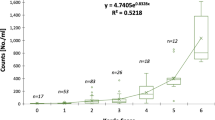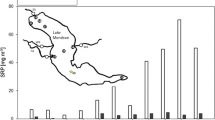Abstract
The most suitable way for standardizing biovolume based assemblage analysis using the Utermöhl technique for counting combined with biomass conversion has not yet been found even though this method has been successfully used in plankton studies for many years. Due to the complexity of the approach easily applicable steps to initially meet primary standard end point or target counts for intra-laboratory standardization tested here seem promising. Examples from count validation and biometric data from the large datasets of three laboratories are given. The first two examples initially intended to quantify the taxon specific scatter of counts by (A) using identical replica of field samples combined with a half-chamber count (scan of every second transect) and the 30 random field approach, respectively, and (B) the replication of transect counts in one sample. Both examples identified relatively low minimum count thresholds to delimit counting errors for single cell counts. The third example identifies shape variability and allometric relationships of the main axes and shows a way to improve taxon specific biomass estimates with special reference to cell thickness. However improved precision of quantitative phytoplankton analysis requires optimization of combined counting strategy and biovolume assessment methods.
Similar content being viewed by others
References
EN 15204, (in press). Water quality—Guidance Standard for the routine analysis of phytoplankton abundance and composition using inverted microscopy (Utermöhl technique). European Committee for Standardization, Brussels.
Hepperle, D., 2005. OPTICOUNT—Software for the enumeration of plankton. Available from: http://science.do-mix.de.
H. Hillebrand C. Dürselen D. Kirschtel U. Pollingher T. Zohary (1999) ArticleTitleBiovolume calculation for pelagic and benthic microalgae Journal of Phycology 35 403–424 Occurrence Handle10.1046/j.1529-8817.1999.3520403.x
R. Hobro E. Willen (1977) ArticleTitlePhytoplankton countings. Intercalibration results and recommendations for routine work Internationale Revue der gesamten Hydrobiologie 62 805–811
E. Hoehn H. A. M. Katelaars B. Ewig (1998) Erfassung und Bewertung von Planktonorganismen. Arbeitsgemeinschaft Trinkwassertalsperren. Technische Informationen 7 Oldenburg Verlag München
J. W. G. Lund C. Kipling E. D. LeCren (1958) ArticleTitleThe inverted microscope method of estimating algal numbers and the statistical basis of estimation by counting Hydrobiologia 11 143–170 Occurrence Handle10.1007/BF00007865
A. Lyakh (2002) ArticleTitleThe free form deformation of phytoplankton models Lecture Notes in Computer Sciences 2331 194–201 Occurrence Handle10.1007/3-540-47789-6_20
A. Nauwerck (1963) ArticleTitleDie Beziehungen zwischen Zooplankton und Phytoplankton im See Erken Symbolae Botanicae Upsalienses 17 1–163
Olrik, K., P. Blomqvist, P. Brettum, G. Cronberg, P. Eloranta, 1998. Methods for quantitative assessment of phytoplankton in freshwaters, part 1. Swedish Environmental Protection Agency, Report 4860, 85 pp.
J. Padisak R. Adrian (1999) Biovolumen W. Tümpling Particlevon G. Friedrich (Eds) Biologische Gewässeruntersuchung Band 2. G. Fischer Jena 334–368
C. S. Reynolds V. Huszar C. Kruk L. Naselli-Flores S. Melo (2002) ArticleTitleToward a functional classification of the freshwater phytoplankton Journal of Plankton Research 24 417–428 Occurrence Handle10.1093/plankt/24.5.417
E. Rott (1981) ArticleTitleSome results from phytoplankton counting intercalibrations Schweizerische Zeitschrift für Hydrologie 43 34–63 Occurrence Handle10.1007/BF02502471
H. Utermöhl (1958) ArticleTitleZur Vervollkommnung der quantitativen Phytoplankton-Methodik Mitteilungen Internationale Vereinigung Theoretische und Angewandte Limnologie 9 1–38
Vuorio, K., L. Lepistö & A. -L. Holopainen, (in press): How to produce comparable data—intercalibrations of freshwater phytoplankton analysis. Boreal Environment Research.
Author information
Authors and Affiliations
Corresponding author
Additional information
In the 14th IAP workshop a general discussion of the topic took place in which unanimously the need for standardization of the quantitative whole community type approach was identified as a main target
Rights and permissions
About this article
Cite this article
Rott, E., Salmaso, N. & Hoehn, E. Quality control of Utermöhl-based phytoplankton counting and biovolume estimates—an easy task or a Gordian knot?. Hydrobiologia 578, 141–146 (2007). https://doi.org/10.1007/s10750-006-0440-5
Issue Date:
DOI: https://doi.org/10.1007/s10750-006-0440-5




